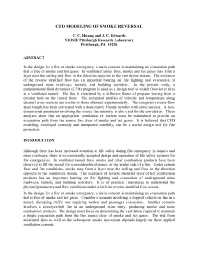Mining Publication: CFD Modeling of Smoke Reversal
Original creation date: June 2001
In the design for a fire or smoke emergency, a main concern is maintaining an evacuation path that is free of smoke and hot gases. In ventilated tunnel fires, smoke and hot gases may form a layer near the ceiling and flow in the direction opposite to the ventilation stream. The existence of the reverse stratified flow has an important bearing on firefighting and evacuation of underground mine roadways, tunnels, and building corridors. In the present study, a computational fluid dynamics (CFD) program is used as a design tool to model floor-level fires in a ventilated tunnel. The fire is simulated by a diffusion flame of propane issuing from a circular hole on the tunnel floor. The computed profiles of velocity and temperature along channel cross sections are similar to those obtained experimentally. The computed reverse-flow layer length has been correlated with a densimatric Froude number with some success. A nondimensional parameter involving the source fire intensity is also used for the correlation. These analyses show that an appropriate ventilation air current must be maintained to provide an evacuation path from the source fire clear of smoke and hot gases. It is believed that CFD modeling, employed correctly and interpreted carefully, can be a useful design tool for fire protection.
Authors: CC Hwang, JC Edwards
Conference Paper - June 2001
NIOSHTIC2 Number: 20021337
Proc International Conference on Engineered Fire Protection Design (Jun 11-15, 2001; San Francisco, CA), Bethesda, MD: Society of Fire Protection Engineers, Inc. :376-387
See Also
- Behavioral and Organizational Dimensions of Underground Mine Fires
- The Critical Ventilation Velocity in Tunnel Fires - A Computer Simulation
- Decision Making During a Simulated Mine Fire Escape
- Emergency Escape and Refuge Alternatives
- How Smoke Hinders Escape from Coal Mine Fires
- Leadership Characteristics in Escape from Three Underground Mine Fires
- Refuge Chamber Expectations Training - 1.0
- Responders to Underground Mine Fires
- Technology News 497 - "You Are My Sunshine": A New Video Release From NIOSH on the Sunshine Mine Fire
- Technology News 549 - MFIRE 3.0 - NIOSH Brings MFIRE into 21st Century
- Page last reviewed: 9/21/2012
- Page last updated: 9/21/2012
- Content source: National Institute for Occupational Safety and Health, Mining Program


 ShareCompartir
ShareCompartir
